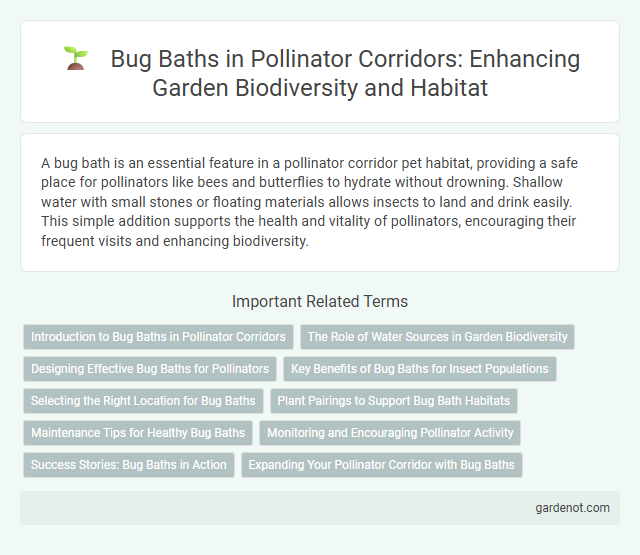A bug bath is an essential feature in a pollinator corridor pet habitat, providing a safe place for pollinators like bees and butterflies to hydrate without drowning. Shallow water with small stones or floating materials allows insects to land and drink easily. This simple addition supports the health and vitality of pollinators, encouraging their frequent visits and enhancing biodiversity.
Introduction to Bug Baths in Pollinator Corridors
Bug baths provide essential water sources for pollinators within pollinator corridors, supporting diverse species such as bees, butterflies, and beetles. Designed with shallow basins filled with pebbles or sand, these baths prevent drowning while allowing insects easy access to hydration. Integrating bug baths into pollinator corridors enhances habitat quality, promotes pollinator health, and boosts ecosystem pollination services.
The Role of Water Sources in Garden Biodiversity
Water sources such as bug baths play a crucial role in enhancing garden biodiversity by providing essential hydration for pollinators like bees, butterflies, and beetles. These accessible water points support the survival and activity of pollinators, promoting effective pollination and healthy plant ecosystems. Integrating bug baths into pollinator corridors helps sustain diverse insect populations and strengthens overall garden resilience.
Designing Effective Bug Baths for Pollinators
Designing effective bug baths for pollinators requires shallow basins with gradual slopes to prevent drowning and allow easy access. Incorporating water-retaining materials like pebbles or sponge pieces provides stable landing spots and maintains moisture. Positioning bug baths in sunny, sheltered areas ensures warmth and protection, encouraging frequent visits from diverse pollinator species.
Key Benefits of Bug Baths for Insect Populations
Bug baths provide essential hydration to pollinators like bees, butterflies, and beetles, helping to sustain their energy and overall health. These shallow water sources with pebbles or sand allow insects to safely drink without drowning, reducing stress on local pollinator populations. By supporting hydration needs, bug baths enhance pollinator activity, contributing to effective pollination and increased biodiversity in the corridor.
Selecting the Right Location for Bug Baths
Selecting the right location for bug baths involves choosing a sunny, sheltered spot close to flowering plants and water sources to attract a diverse range of pollinators. Positioning the bug bath near native shrubs or wildflowers ensures easy access for beneficial insects while providing protection from strong winds. Incorporating shallow dishes or concrete birdbaths with smooth stones offers pollinators safe landing spots to drink and cool down within the corridor.
Plant Pairings to Support Bug Bath Habitats
Plant pairings in pollinator corridors enhance bug bath habitats by combining nectar-rich flowers like milkweed with moisture-retaining foliage such as ferns. These combinations provide essential hydration and nutrition, attracting diverse beneficial insects like bees, butterflies, and ladybugs. Integrating native plants such as coneflowers and goldenrod ensures sustained habitat support while boosting pollination and biodiversity.
Maintenance Tips for Healthy Bug Baths
Regularly changing the water in a bug bath prevents mosquito larvae buildup and keeps insects hydrated safely. Removing debris such as fallen leaves and algae growth maintains clean surfaces, promoting a healthy habitat for pollinators. Placing small stones or twigs inside the bath offers landing spots, reducing the risk of drowning and encouraging continuous pollinator visits.
Monitoring and Encouraging Pollinator Activity
Bug baths provide essential hydration for pollinators, supporting their health and increasing activity levels. Monitoring involves regular observation and recording of species visiting the bath, helping to track pollinator diversity and behavior trends. Encouraging pollinator activity includes placing bug baths near native flowering plants and ensuring clean, fresh water to attract a wider range of pollinating insects.
Success Stories: Bug Baths in Action
Bug baths have significantly boosted pollinator health by providing vital hydration and habitat diversity within pollinator corridors. Success stories reveal increased activity of native bees and butterflies around these water sources, enhancing local biodiversity and crop pollination rates. Integrating bug baths into conservation strategies has proven effective in supporting sustainable pollinator populations.
Expanding Your Pollinator Corridor with Bug Baths
Bug baths provide a crucial water source for pollinators like bees and butterflies, enhancing the health and diversity of your pollinator corridor. Installing shallow, pebble-lined bug baths encourages regular hydration and supports pollinator activity throughout the growing season. Integrating these water features into green spaces promotes a thriving ecosystem vital for plant pollination and biodiversity.
Bug bath Infographic

 gardenot.com
gardenot.com